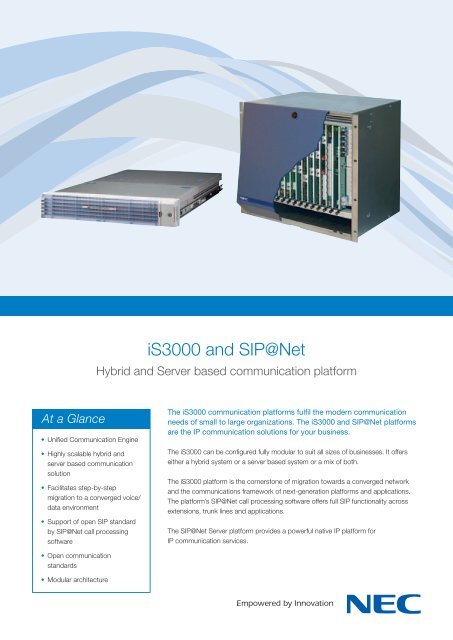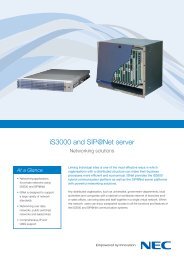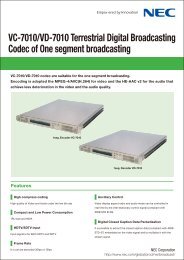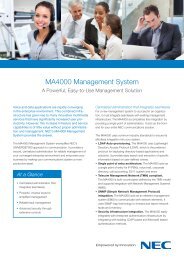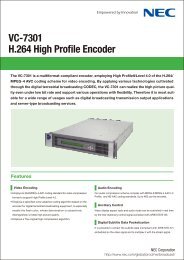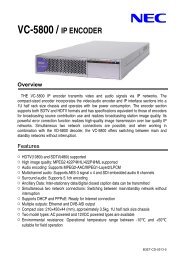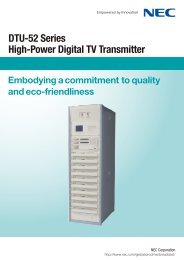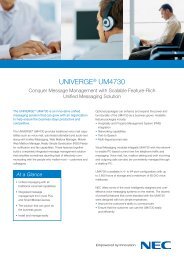iS3000 and SIP@Net - Nec - Netcom - Activ
iS3000 and SIP@Net - Nec - Netcom - Activ
iS3000 and SIP@Net - Nec - Netcom - Activ
Create successful ePaper yourself
Turn your PDF publications into a flip-book with our unique Google optimized e-Paper software.
At a Glance<br />
• Unified Communication Engine<br />
• Highly scalable hybrid <strong>and</strong><br />
server based communication<br />
solution<br />
• Facilitates step-by-step<br />
migration to a converged voice/<br />
data environment<br />
• Support of open SIP st<strong>and</strong>ard<br />
by <strong>SIP@Net</strong> call processing<br />
software<br />
• Open communication<br />
st<strong>and</strong>ards<br />
• Modular architecture<br />
<strong>iS3000</strong> <strong>and</strong> <strong>SIP@Net</strong><br />
Hybrid <strong>and</strong> Server based communication platform<br />
The <strong>iS3000</strong> communication platforms fulfi l the modern communication<br />
needs of small to large organizations. The <strong>iS3000</strong> <strong>and</strong> <strong>SIP@Net</strong> platforms<br />
are the IP communication solutions for your business.<br />
The <strong>iS3000</strong> can be configured fully modular to suit all sizes of businesses. It offers<br />
either a hybrid system or a server based system or a mix of both.<br />
The <strong>iS3000</strong> platform is the cornerstone of migration towards a converged network<br />
<strong>and</strong> the communications framework of next-generation platforms <strong>and</strong> applications.<br />
The platform’s <strong>SIP@Net</strong> call processing software offers full SIP functionality across<br />
extensions, trunk lines <strong>and</strong> applications.<br />
The <strong>SIP@Net</strong> Server platform provides a powerful native IP platform for<br />
IP communication services.
Key features<br />
• Highly scalable hybrid <strong>and</strong> server based communication<br />
solution offering TDM <strong>and</strong> IP telephony<br />
• Modular architecture for flexible <strong>and</strong> exp<strong>and</strong>able system<br />
configuration<br />
• Facilitates step-by-step migration to a converged voice/data<br />
environment<br />
• Support of open SIP st<strong>and</strong>ard by <strong>SIP@Net</strong> call processing<br />
software<br />
• <strong>SIP@Net</strong> IP call-processing software platform adds feature<br />
richness <strong>and</strong> enables the easy addition of future applications<br />
• In-System IP gateway for IP trunks <strong>and</strong> IP extensions<br />
• Open communication st<strong>and</strong>ards enable the integration of<br />
external applications<br />
• Very high system availability<br />
• Fast loading <strong>and</strong> restart times<br />
• 19-inch housing<br />
• Economical power consumption<br />
• Suitable for high levels of communication traffic <strong>and</strong><br />
multifunctional applications.<br />
2<br />
General architecture<br />
The <strong>iS3000</strong> architecture provides a combination of IP<br />
telephony <strong>and</strong> traditional solutions by combining the best of<br />
hybrid <strong>and</strong> server based technology. Besides the <strong>iS3000</strong> full<br />
hybrid PBX, a server version is part of the communication<br />
platform family. It supports the broad range of critical voice<br />
features <strong>and</strong> functions with which users are familiar, now in<br />
a converged network environment.The IP call-processing<br />
software platform - <strong>SIP@Net</strong> - forms the basis for both the<br />
hybrid <strong>and</strong> the server solution of migration to a converged<br />
network.<br />
An In-System IP Gateway (ISG) incorporated within the hybrid<br />
<strong>iS3000</strong> provides an embedded IP-switching module, which<br />
registers, interconnects <strong>and</strong> processes all IP end-points on<br />
the network, covering a wide range of SIP-based devices.<br />
The ISG also provides trunking between <strong>iS3000</strong> systems,<br />
<strong>SIP@Net</strong> servers <strong>and</strong> SIP providers.<br />
Uniform hardware architecture <strong>and</strong> a common software<br />
platform produce a scalable hybrid PBX that can be tailored<br />
to meet the needs of different organizations, through<br />
customization or the addition of applications <strong>and</strong>/or capacity.<br />
This uniform hardware platform is based on distributed<br />
architecture that divides the <strong>iS3000</strong> hybrid platform into<br />
functional modules:<br />
• Central processor Module (CM): responsible for overall<br />
system operation, storage of user data <strong>and</strong> providing central<br />
access to external applications.<br />
• IP-switching Module (In-System Gateway): registers,<br />
interconnects <strong>and</strong> processes IP end-points, such as SIP<br />
IP phones.<br />
• Peripheral Module (PM): houses the plug-in boards that<br />
interface with end-user devices. A PM has access to up to<br />
320 64 Kbits/s transmission paths <strong>and</strong> can accommodate<br />
up to 10 plug-in boards. Larger systems can be assembled<br />
by adding PMs as required (up to a maximum of 31).<br />
This distributed architecture relieves the central module of<br />
critical <strong>and</strong> time-consuming tasks, such as end-user<br />
equipment administration, <strong>and</strong> by separating the system into<br />
modules, improves its overall reliability.
Central processor Module<br />
The characteristics of the hybrid <strong>iS3000</strong> system depends on<br />
the choice of processor unit, which comes in two variants:<br />
• Single-card Central processor Module; <strong>and</strong><br />
• Multi-card, fault-tolerant Central processor Module.<br />
A single, common operating system provides a uniform<br />
software platform for call processing, operational maintenance,<br />
system assurance <strong>and</strong> the various end-user applications included<br />
in the <strong>SIP@Net</strong> system software. Freely configurable I/O<br />
ports enable the central connection of external applications,<br />
such as Microsoft Communicator, management systems,<br />
call logging devices, maintenance terminals, contact centre<br />
supervisors or remote service/management centres. The initial<br />
system configuration <strong>and</strong> subsequent software upgrades of<br />
an <strong>iS3000</strong> are performed by downloading the system software<br />
<strong>and</strong> user data from an Operational Maintenance PC.<br />
DECT<br />
h<strong>and</strong>sets<br />
Digital<br />
business<br />
phones<br />
Analogue<br />
phone/fax<br />
DECT<br />
radio<br />
SIP<br />
provider<br />
ISDN<br />
PSTN<br />
Applications (VM, UM, IM,<br />
Presence, OCS, exchange, Call Centre, ...)<br />
Single-card Central processor Module<br />
The heart of the Central processor Modules is the CPU4000<br />
that consist of a combination of Server Interface Card (SIC)<br />
<strong>and</strong> In Skin Server (ISS). It offers a flexible, powerful, high<br />
performance Central Processor function for the <strong>iS3000</strong><br />
single processor communication platform. The In Skin Server<br />
is an industrial grade processor board running embedded<br />
WindowsXP operating system. It includes a 2 Gb flashdisc <strong>and</strong><br />
at least a 0.5 Gb Ram for memory functions. The CPU4000<br />
increases the <strong>iS3000</strong> system’s IP capabilities to their full extent.<br />
Up to 1216 ports (either full SIP or TDM or a mix) can be<br />
realized easily with this new industrial processor unit.<br />
The CPU4000 has 3 ethernet ports <strong>and</strong> 4 USB ports<br />
for management, control, dongle connection <strong>and</strong> future<br />
applications. An onboard battery powers the on board real<br />
time clock if wanted.<br />
Instead of using the In Skin Server, an external server can be<br />
applied to perform the system processor task. The external<br />
server offers flexibility in availability, interfaces, outline <strong>and</strong><br />
future growth.<br />
Internet<br />
router<br />
SIP/ISDN<br />
gateway<br />
In-System<br />
Gateway<br />
<strong>iS3000</strong><br />
<strong>SIP@Net</strong><br />
server<br />
LAN<br />
DECT<br />
access point<br />
WLAN<br />
access point<br />
SIP<br />
converters<br />
DECT<br />
h<strong>and</strong>sets<br />
WLAN<br />
h<strong>and</strong>sets<br />
Smartphone<br />
SIP<br />
softphones/<br />
videophone<br />
SIP<br />
business<br />
phones<br />
BaseLine<br />
SIP phones<br />
Analogue<br />
phone/fax<br />
3
Multi-card, fault-tolerant Central processor Module<br />
The fault-tolerant Central processor Module ensures maximum<br />
system availability. Four identical Central Control Slices<br />
(CCS) operate in parallel, according to Philips’ patented (4/2)<br />
concept.The four processors synchronously execute the same<br />
instructions <strong>and</strong> these are continuously verified by an<br />
automatic error recovery algorithm.<br />
This algorithm is implemented in the hardware <strong>and</strong> ensures<br />
that a single- or double-bit fault, <strong>and</strong> even a fault that has<br />
affected an entire instruction, is detected <strong>and</strong> recovered<br />
without any loss of system continuity.This continuous process<br />
of hardware verification ensures that memory faults, processor<br />
faults or even the breakdown of an entire CCS are ruled out<br />
instantaneously, without the need for complex diagnostic<br />
software.<br />
IP-switching Module (In-System Gateway)<br />
The IP-enabling functions for trunks <strong>and</strong> extensions are made<br />
available through In-System Gateways (ISG), of which up to<br />
10 are available per system. The ISG is part of the IP concept,<br />
allowing the establishment of VoIP media channels between an<br />
<strong>iS3000</strong> series system <strong>and</strong> IP terminals, the IP DECT infrastructure,<br />
or the SOPHO SIP server. It also allows the establishment<br />
of system-to-system media-channels (IP trunks). For an IP<br />
connection to non-<strong>iS3000</strong>/<strong>SIP@Net</strong> systems, the ISG offers<br />
SIP <strong>and</strong> H.323 based interfaces.<br />
Each ISG requires one slot/unit group <strong>and</strong> the ISG offers 10 IP<br />
channels as st<strong>and</strong>ard. Up to 30 channels per ISG are possible<br />
<strong>and</strong> each ISG offers a 10/100baseT Ethernet interface. The<br />
ISG supports voice compression according to G.711 <strong>and</strong><br />
G.729A,T38 fax support for <strong>iS3000</strong> networks <strong>and</strong> has an onboard<br />
power supply. ISG supports secure communication by<br />
applying the SRTP <strong>and</strong> TLS st<strong>and</strong>ards.<br />
Peripheral Module<br />
The Peripheral Module houses the plug-in boards that provide<br />
the interface with end-user equipment. One unit group shares<br />
32 time-slots on the switching network, via a dedicated<br />
2Mbits/s backplane bus. A few special positions have access<br />
to a full 2Mbits/s group. Different types of plug-in board can be<br />
freely mixed across the available positions. A plug-in board can<br />
be inserted in a free position without disconnecting the power<br />
or restarting the system.<br />
Plug-in boards<br />
A wide variety of plug-in boards is available to interface<br />
an <strong>iS3000</strong> system with all major types of analogue, digital<br />
or IP extensions, along with business phones, IP phones,<br />
public trunks, private tie-lines, IP trunks, cordless h<strong>and</strong>sets,<br />
integrated announcers, operator consoles, voice processing<br />
systems, front-end office equipment <strong>and</strong> conference units.<br />
4<br />
Each plug-in board has been carefully designed to support a<br />
maximum number of circuits (between four <strong>and</strong> 32, depending<br />
on the interface type <strong>and</strong> the complexity of the wiring scheme).<br />
Multifunctional plug-in boards are provided to facilitate <strong>and</strong><br />
optimize system configuration.This applies in particular to<br />
the 2B+D ISDN card, which can be set in different modes:<br />
extension, trunk or tie line.<br />
The In-System IP Gateway card controls the IP interfacing for<br />
simultaneous IP extension, IP trunk, IP DECT or IP server use.<br />
<strong>SIP@Net</strong> server<br />
To fullfil the dem<strong>and</strong> for traditional voice services along<br />
with driving new growth in next-generation Voice over IP<br />
(VoIP) services, NEC’s offer includes the <strong>SIP@Net</strong> server.<br />
This <strong>SIP@Net</strong> server provides a powerful server based platform<br />
for IP communication services. It also lays the base for Unified<br />
Communications such as integration of voice, IM, video,<br />
data <strong>and</strong> presence.<br />
The server offers the <strong>iS3000</strong> full SIP based interfaces for<br />
extensions, networking, trunking <strong>and</strong> application use.<br />
The <strong>SIP@Net</strong> server seamlessly connects to the hybrid <strong>iS3000</strong><br />
systems <strong>and</strong> so offers the full range of network interfaces for<br />
operation in present networks.<br />
Existing <strong>iS3000</strong> installations <strong>and</strong> customers will also benefit<br />
from easy migration <strong>and</strong> re-use of line equipment by adding a<br />
<strong>SIP@Net</strong> server to their network.<br />
<strong>SIP@Net</strong> server principle<br />
One of the basic SIP characteristics, the so-called peer to<br />
peer communication, created the possibility of building a<br />
voice communication platform without the need of a physical<br />
switching function.<br />
With <strong>SIP@Net</strong> software running on a server <strong>and</strong> Windows<br />
operating system, a SIP server is made available to execute<br />
all call processing functions required for SIP based endpoints<br />
(wired, IP DECT, VoWLAN, smart phones), SIP trunking <strong>and</strong><br />
SIP based networking.<br />
Using <strong>SIP@Net</strong> on a server, all IP based iSNet networking<br />
options are available to network to a hybrid <strong>iS3000</strong> system<br />
for expansion or migration scenarios. The application ideally<br />
suited in combination with the <strong>SIP@Net</strong> server is Business<br />
ConneCT, offering a full integrated solution for Operator, Call<br />
Agent or Employee functionality. The <strong>SIP@Net</strong> server runs on<br />
Windows server operating system, <strong>and</strong> installed on an industry<br />
server it offers maximum flexibility on the processor, power,<br />
performance <strong>and</strong> availability.
Interfaces hybrid series<br />
The following is an overview of the wide variety of interface<br />
types supported by the different plug-in boards for the <strong>iS3000</strong><br />
hybrid series.<br />
Analogue extensions:<br />
• Tone/pulse dialling<br />
• Earth, flash, dial one recall<br />
Digital extensions:<br />
• B+D Uko (2-wire, 2B1Q)<br />
• 2B+D Upn (2-wire, Philips)<br />
• 2B+D S0 (4-wire, ISDN TBR3)<br />
IP extensions<br />
• 10/100 Mbit/s Ethernet<br />
• TCP/IP<br />
• G.711 A-law, G.729A,AB<br />
• QoS (802.1Q/p,ToS)<br />
• SIP (RFC 3261)<br />
• TLS, SRTP<br />
Cordless extensions:<br />
• DECT (GAP st<strong>and</strong>ard)<br />
• WLAN (SIP st<strong>and</strong>ard)<br />
Analogue trunks:<br />
• Subscriber signalling<br />
• DDI/DDO via pulse, MFC, DTMF<br />
• Polarity detection<br />
• Metering (50Hz, 12/16 kHz)<br />
• Power failure switch (ESU)<br />
Digital trunks:<br />
• Euro ISDN:<br />
- ISDN Basic rate TBR3 (2B+D)<br />
- SDN Primary rate TBR4 (30B+D)<br />
• Channel Associated (CAS –2Mb/s):<br />
- MFC<br />
IP trunks:<br />
• 10/100 Mbit/s Ethernet<br />
• TCP/IP, H.323,T.38<br />
• G.711 A-law, µ-law, G.729A, AB<br />
• ECMA 333<br />
• QoS (802.1Q/p,ToS)<br />
• SIP (RFC 3261)<br />
• SRTP, TLS<br />
Analogue tie-lines:<br />
• CEPT-L1<br />
• E&M (2/4 wire)<br />
• Loop disconnect<br />
• Local battery<br />
Digital tie-lines:<br />
• 2B+D or 30B+D with:<br />
- BT DPNSS<br />
- ETSI QSIG<br />
CSTA interface:<br />
10Mb Ethernet TCP/IP connection (ECMA-179 Services<br />
CSTA phase 1).<br />
Interfaces <strong>SIP@Net</strong> server<br />
The following interface types are supported by the<br />
<strong>SIP@Net</strong> server:<br />
IP extensions/trunk/network/application<br />
• Ethernet based<br />
• TCP/IP<br />
• G.711 A-law, G.729A,AB<br />
• QoS (802.1Q/p,ToS)<br />
• SIP (RFC 3261)<br />
CSTA interface<br />
Ethernet based TCP/IP connection (ECMA-179 Services<br />
CSTA phase 1).<br />
5
Technical data<br />
Power supply<br />
The 19-inch based <strong>iS3000</strong> single processor <strong>and</strong> the <strong>iS3000</strong><br />
redundant processor can be powered directly from the mains.<br />
An optional battery back-up system or Uninterrupted Power<br />
Supply (UPS) can be installed to ensure continuous operation<br />
in the event of a power failure.<br />
Mains:<br />
• 230 Volt AC (+10%, -15%), 40-60 Hz<br />
• Safety class 1 (IEC) 60950-1<br />
• Battery: 42 - 60V DC<br />
Power consumption<br />
3 Volt CMOS technology keeps power consumption at an<br />
extremely low level.Typical power consumption figures are:<br />
• 70 W for each 19-inch PM shelf<br />
• 0.7 W for each analogue extension<br />
• 180 W for <strong>iS3000</strong> fault tolerant 19-inch shelf<br />
For digital extensions, these figures depend on the terminals<br />
connected. Each digital port supplies power to one or more ISDN<br />
terminals, in accordance with the ETS300012 st<strong>and</strong>ard (max. 4 W).<br />
Performance<br />
• <strong>iS3000</strong> single:<br />
- 50,000 Busy Hour Call Attempts<br />
• <strong>iS3000</strong> fault-tolerant version:<br />
- 50,000 Busy Hour Call Attempts<br />
• <strong>SIP@Net</strong> server:<br />
- 100.000 busy Hour Call Attempts<br />
Performance figures depend on the system configuration <strong>and</strong><br />
software release.<br />
Traffic<br />
• <strong>iS3000</strong> single: 600 Erlang<br />
• <strong>iS3000</strong> fault tolerant: 3,000 Erlang<br />
• <strong>SIP@Net</strong> server: 3,000 Erlang<br />
Transmission<br />
Pulse Code Mode (PCM) coding in accordance with A-Law<br />
CCITT G711/712.<br />
Switching<br />
Non-blocking Time Division Multiplex (TDM) switching matrix,<br />
using 64 Kbits/s time-slots.<br />
6<br />
System capacity<br />
System availability<br />
State-of-the-art technology is used in order to reduce to an<br />
absolute minimum the number of system cards that can cause<br />
a failure.The fault-tolerant architecture has the capability of<br />
tolerating a card <strong>and</strong>/or link failure without any loss of system<br />
continuity.<br />
• <strong>iS3000</strong> fault tolerant: >99.999%<br />
• <strong>iS3000</strong> single: >99.97%<br />
• <strong>SIP@Net</strong> server: server dependent<br />
System capacity<br />
Single <strong>SIP@Net</strong> Fault tolerant<br />
processor server processor<br />
Max. no. of 19-inch shelves 4 n.a. 31<br />
Max. no. of Remote 4 n.a. 15<br />
Peripheral Modules<br />
Max. no. of ports 1) 1216 n.a. 10000<br />
Max. no. of cordless DECT 1216 2560 2560<br />
h<strong>and</strong>sets (0.2 Erlang) 1)<br />
Max. no. of IP ports 1216 5000 1000<br />
(0.2 Erlang)<br />
Max. no. of trunks <strong>and</strong>/or 600 n.a. 2500<br />
tie-lines<br />
Max. no. of IP trunks 300 600 300<br />
Max. no. of operators 8 12 31<br />
1) the actual number of (usable) ports/subscriptions is determined<br />
by the installed software license.<br />
Mean Time Between (Fatal) Failure:<br />
• <strong>iS3000</strong> fault tolerant: > 250 years<br />
• <strong>iS3000</strong> single: > 7.5 years<br />
• <strong>SIP@Net</strong> server: server dependent<br />
The above figures assume a mean time to repair of two days.<br />
Interface compliance<br />
The <strong>iS3000</strong> Series complies with European Directives:<br />
– 2006/95/EC (Safety);<br />
– 2004/108/EC (EMC);<br />
– 1999/5/EC (R&TTE);<br />
– <strong>and</strong> the Council Recommendation 1999/519/EC (EMF).<br />
Telecommunication Interfaces in compliance with:<br />
• ISDN Basic Rate:TBR3<br />
• ISDN Primary Rate:TBR4<br />
• DECT: EN 301 406 (TBR6), TBR10, TBR22<br />
• PSPDN X25:TBR2<br />
• 64 kbit/s digital unrestricted leased lines:TBR14
System Housing<br />
The <strong>iS3000</strong> 19-inch housing is available for the Single<br />
Processor, the Fault-tolerant Processor <strong>and</strong> server based<br />
platforms. The <strong>iS3000</strong> is available as an AC- or DC-powered<br />
system. <strong>iS3000</strong> is a modular communication platform that<br />
fulfils the modern communication needs of small to large<br />
organizations.<br />
The CSM <strong>and</strong> PM are industry-st<strong>and</strong>ard 19-inch units.<br />
19-inch style patch panels are available for easy installation of<br />
the complete system into a single 19-inch cabinet.<br />
The universal design of the CSM <strong>and</strong> PM allows stacking in a<br />
floor-st<strong>and</strong>ing configuration of up to four modules. Side panels<br />
are available as an option.<br />
Application area<br />
Powered by <strong>SIP@Net</strong>, a <strong>iS3000</strong> Single Processor system as<br />
well as the <strong>iS3000</strong> Fault-tolerant system can be deployed in<br />
virtually any VoIP, digital or analogue telephony network.<br />
The large variety of interface boards available in the <strong>iS3000</strong><br />
product range <strong>and</strong> supported by the <strong>iS3000</strong> 19-inch systems<br />
ensures a high level of investment protection.<br />
The system allows expansion into the IP-connected world.<br />
Full SIP functionality is offered across extensions, trunk lines<br />
<strong>and</strong> applications. The industry-st<strong>and</strong>ard 19-inch form factor<br />
allows seamless integration into today’s IT environment.<br />
Having the choice of AC or DC powering, enables customers<br />
to select the powering option that suits their needs; the ease<br />
of use <strong>and</strong> universal availability of AC power, versus a batterybacked<br />
up DC power solution for high availability.<br />
Components<br />
Control <strong>and</strong> Switching Module<br />
The Control <strong>and</strong> Switching Module (CSM) contains the<br />
Fault-tolerant Processor <strong>and</strong> central switching matrix.<br />
Control <strong>and</strong> Switching Module<br />
Peripheral Module<br />
The Peripheral Module contains system boards, which provide<br />
extension <strong>and</strong> trunk interfaces to end-user <strong>and</strong> carrier equipment.<br />
One of the Peripheral Modules in the Single Processor system<br />
also contains the processor board or Server Interface Card.<br />
The CSM, the PM, DDU <strong>and</strong> patch panel are designed for<br />
installation in an industry-st<strong>and</strong>ard 19-inch cabinet according<br />
to IEC 60297-2. The CSM <strong>and</strong> PM may also be fitted into<br />
19-inch cabinets conforming to IEC 60917-2 or ETS 300 119-3.<br />
The DDU <strong>and</strong> the patch panel do not fit in these cabinets,<br />
so these configurations should be AC-powered.<br />
Peripheral Module<br />
7
Up to four Peripheral Modules may be stacked on top of each<br />
other in a self-supporting floor-st<strong>and</strong>ing configuration. In this<br />
case the DC Distribution Unit with adjustable feet acts as floorst<strong>and</strong><br />
too.<br />
A single Peripheral Module can be fixed to a wall by way of a<br />
Wall Mount Bracket 19-inch.<br />
Floor-st<strong>and</strong>ing <strong>and</strong> wall-mounted Peripheral Modules can be<br />
provided with decorative side panels. Two sizes are available:<br />
the Side Panel Set 9U 19-inch which covers a single PM (top<br />
right) <strong>and</strong> the Side Panel Set 12U 19-inch which covers a<br />
combination of a PM <strong>and</strong> a DC Distribution Unit (bottom right).<br />
Left to right: 19-inch rack, floorst<strong>and</strong>ing cabinets with <strong>and</strong><br />
without side panels<br />
For stack mount each of the modules is fixed to the lower<br />
module both at the front <strong>and</strong> at each side.<br />
Fixation front inside Fixation at the side<br />
8<br />
AC Power Unit 19-inch<br />
The AC Power Unit integrates fully with the Peripheral Module<br />
transforming it from a DC-powered into an AC-powered PM.<br />
AC Power Unit 19-inch separate (left) <strong>and</strong> built-in (right)<br />
This high-quality power supply accepts AC mains voltage in<br />
the range of 100 to 240V <strong>and</strong> generates 48V DC. The MTBF is<br />
specified at 100,000 hours at 30°C (MIL-HBK-217F). The<br />
Fault-tolerant CSM module is equipped with two AC Power<br />
Units. Whatever the power source (AC or DC), power supply<br />
operation is continuously monitored during normal operation.<br />
Malfunction is detected <strong>and</strong> reported as an alarm via the Alarm<br />
Cable CSM 19-inch supplied with each CSM.<br />
Backside of CSM shelf with two AC Power Units<br />
RJ45 2/4W patch panel 19-inch<br />
This versatile 1U high patch panel is mounted in a 19-inch<br />
cabinet <strong>and</strong> provides three groups of eight interfaces.<br />
RJ45 2/4W patch panel 19-inch<br />
Each group can be used as either 2-wire or 4-wire interfaces,<br />
to which industry-st<strong>and</strong>ard RJ45 jacks can be connected.<br />
Connection with the PM is by way of well-known F122-based<br />
cables. In case external alarm signals are to be mixed with<br />
Power alarm <strong>and</strong> Fan alarm, a dedicated RJ45 2/4W Patch<br />
Panel 19-inch is required to select alarm input assignments.<br />
One cable F122 from the backplane <strong>and</strong> two cables to the CIE<br />
board are then required.
Sofycom bracket 19-inch<br />
This bracket accommodates up to 48 traditional ‘10DA’<br />
Sofycom-style modules, arranged in two columns of 24<br />
modules. The bracket has the same height as the Peripheral<br />
Module <strong>and</strong> can be installed in a 19-inch cabinet. It can also<br />
be fixed to a wall.<br />
Left: Sofycom bracket 19-inch, right: wall-mount bracket 19-inch<br />
DC Distribution Unit 19-inch<br />
This 3U high module safely <strong>and</strong> reliably distributes DC power<br />
from an external DC power supply to up to four Peripheral<br />
Modules.<br />
The DC Distribution Unit also serves as a floor-st<strong>and</strong> for a<br />
stacked configuration of PMs, in which adjustable feet 19-inch<br />
are required to level the system.<br />
Left: DC Distribution Unit, right: adjustable feet 19-inch<br />
Fan unit 19-inch<br />
Adequate cooling of the Peripheral Module under all operating<br />
conditions is provided by an integrated fan unit, which can be<br />
hot-swapped <strong>and</strong> thus allows uninterrupted telephony service.<br />
19-inch fan unit<br />
Each PM <strong>and</strong> each CSM comes equipped with a fan unit. MTBF<br />
of the individual fans is specified at 80,000 hours at 40°C.<br />
Fan operation is continuously monitored during normal operation.<br />
Malfunction is detected <strong>and</strong> reported as an alarm via the<br />
Alarm Cable CSM 19-inch supplied with each CSM.
Technical specification<br />
Capacity <strong>iS3000</strong> Single Processor system<br />
The SOPHO <strong>iS3000</strong> Single Processor system is available in<br />
one to four Peripheral Modules. System capacity scales accordingly<br />
up to a maximum of 1216 ports. System capacity in<br />
terms of traditional analogue or digital extensions is as follows:<br />
Number of PMs Analogue ext. Digital ext.<br />
1 256 270<br />
2 512 570<br />
3 768 840<br />
4 1024 1140<br />
Each Peripheral Module accommodates one non-blocking<br />
Peripheral Module Controller (PMC) <strong>and</strong> up to 12 Peripheral<br />
Circuit (PCT) Boards, spread over 10 Unit Groups (0-9).<br />
Capacity <strong>iS3000</strong> Fault-tolerant Processor system<br />
The <strong>iS3000</strong> Fault-tolerant Processor system is available in<br />
one Control <strong>and</strong> Switching Module plus 1 to 24 Peripheral<br />
Modules. System capacity scales accordingly at about 300<br />
digital endports per PM:<br />
Number of PMs Analogue ext. Digital ext.<br />
1 256 300<br />
2 512 600<br />
3 768 900<br />
Etc.<br />
Up to 10,000 ports are supported by a single node with the<br />
maximum number of 24 PMs. Expansion to up to 65,000 ports<br />
is supported in a distributed arrangement of 14 nodes.<br />
The Control <strong>and</strong> Switching Module accommodates four<br />
processor slices arranged in a (4,2) fault-tolerant configuration<br />
<strong>and</strong> two to six redundant switching network slices.<br />
The switching network is non-blocking when equipped with<br />
six network slices.
Compatibility<br />
Existing <strong>iS3000</strong> systems can be upgraded to CSM/PM<br />
19-inch modules. The PM 19-inch module can also be used<br />
as Remote Peripheral Module. Existing <strong>iS3000</strong> cards can be<br />
placed in the CSM or PM 19-inch modules.<br />
Physical characteristics<br />
• Dimensions CSM <strong>and</strong> PM 19-inch<br />
– Width 483 mm (19-inch)<br />
– Height 400 mm (9 U)<br />
– Depth 408 mm; 468 mm including front cover<br />
• Weight: 15 kg excluding system boards <strong>and</strong> AC Power Unit<br />
• Colour: Front cover (NEC) purple<br />
Power<br />
The basic CSM <strong>and</strong> PM 19-inch are DC-powered. They can<br />
be AC-powered by insertion of one or two AC Power Units<br />
19-inch (two units in CSM only).<br />
• Operating voltage range:<br />
– AC: 100 to 240V, 47 to 63 Hz<br />
– DC: 42 to 60V, positive ground<br />
– Safety class (IEC) 60950-1<br />
Compliance<br />
• European Directives<br />
– Safety: 2006/95/EC<br />
– EMC: 2004/108/EC<br />
– R&TTE: 1999/5/EC<br />
– EU RoHs: 2002/95/EC<br />
– WEEE: 2002/96/EC<br />
• Council Recommendation<br />
– EMF 1999/519/EC<br />
• European St<strong>and</strong>ards<br />
– EN55022<br />
– EN55024<br />
– EN61000-3-2<br />
– EN61000-3-3<br />
– EN60950-1<br />
– EN50371<br />
MTBF<br />
• AC PSU: 100,000 hrs (MIL-HBK-217F) at 30°C<br />
• Fan: 80,000 hrs at 40°C<br />
Environmental conditions<br />
• ETS 300 019<br />
– storage class 1.2<br />
– transportation class 2.3<br />
– stationary use class 3.1<br />
• Temperature: –5° to +45°C<br />
• Humidity: 10 to 85%<br />
Expert Services<br />
The <strong>iS3000</strong> <strong>and</strong> <strong>SIP@Net</strong> is fully supported by our Expert<br />
Services. This extensive portfolio of services provides the<br />
insight <strong>and</strong> support needed to get the most out of equipment<br />
<strong>and</strong> applications.The services offered comprise advice, design,<br />
customization, integration, training, maintenance, continuous<br />
optimisation <strong>and</strong> Business Partner services.<br />
11
10-002-02 June 10 © 2010 NEC Corporation. All rights reserved. NEC <strong>and</strong> the NEC logo are trademarks or registered trademarks of NEC Corporation that may be registered in Japan <strong>and</strong> other jurisdictions. All trademarks identified with © or TM are registered trademarks or trademarks of their respective owners.<br />
Models may vary for each country, <strong>and</strong> due to continuous improvements this specification is subject to change without notice. Please refer to your local NEC representative(s) for further details.<br />
About NEC Corporation: NEC Corporation (NASDAQ: NIPNY) is one of the world’s leading providers of Internet, broadb<strong>and</strong> network <strong>and</strong> enterprise business solutions dedicated to meeting the specialized needs of its diverse <strong>and</strong><br />
global base of customers. NEC delivers tailored solutions in the key fields of computer, networking <strong>and</strong> electron devices, by integrating its technical strengths in IT <strong>and</strong> Networks, <strong>and</strong> by providing advanced semiconductor solutions<br />
through NEC Electronics Corporation. The NEC Group employs more than 150,000 people worldwide. For additional information, please visit the NEC home page at: http://www.nec.com<br />
For further information please contact your local NEC representative or:<br />
EMEA (Europe, Middle East, Africa)<br />
NEC Unified Solutions<br />
www.nec-unified.com<br />
UNIVERGE ® 360 is NEC’s approach to unifying<br />
business communications. It places people<br />
at the center of communications <strong>and</strong> delivers<br />
on an organization’s needs by uniting<br />
infrastructure, communications <strong>and</strong> business.<br />
North America (USA)<br />
NEC Corporation of America<br />
www.necam.com<br />
Corporate Headquarters (Japan)<br />
NEC Corporation<br />
www.nec.com


